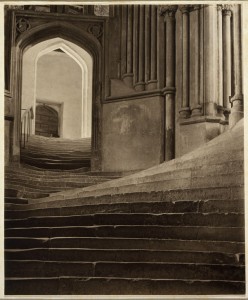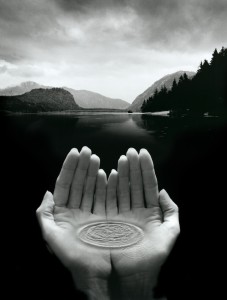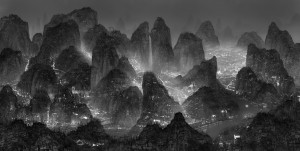Basically, there are only two categories of art photography, the found and the made. I realize that is like claiming there are basically only two categories of color, whereas the overall reality for photography, as with color, is spectrum. Nonetheless, at some level, a photographer either finds an image by capturing an existing scene, or makes an image by creating a scene to be captured. Photographers who specialize in finding the scene are finders; those who specialize in creating the scene are makers.
The finder is one who sees beyond vision to recognize, as most do not, that this particular scene—if rendered just so—may reveal an existential, if not essential, narrative. With this specific ability to see beyond vision and recognize something beyond the obvious, the finder shares a soul most closely with the plein air painter.

The maker shares a soul with the assemblage sculptor; the maker is essentially an assemblage sculptor who works, ultimately, in two rather than three dimensions. As does the assemblage sculptor, the maker forms a narrative in her mind, and then realizes that idea by creating an arrangement of materials and light in front of the camera. For the maker, the final rendering of the idea, that is, the expression of the narrative, is embodied in a two-dimensional arrangement of silver halide grains (or pigment dots, or pixels), rather than an arrangement of metal, stone, wood, or other materials in three dimensional space.
Regardless of the approach, finding or making, if the resultant photograph is to be considered truly artful, the image must suggest some aspect that relates to the human existence. For art that does not inherently and ultimately deal with some universal human concern is limited as it generally will not resonate with the external viewer for long if at all, and likely will not survive separation from the artist’s statement. Since the narrative is the most essential element of visual art, the ability to recognize narrative is the most important talent for a photographer. It is more important than the ability to pre-visualize how the six dimensions (three dimensions of space, plus time, color, and value) of the found or made scene may be rendered in the frame of a two dimensional photograph. It is more important even than the skill to render the pre-visualized image into a photograph composed of silver crystals or pixels. It is by virtue of this ability to see or conjure some aspect that stirs the human heart that the photographer, whether a finder or maker, shares a soul with all other types of visual artists.

A thoroughly unsystematic review of the history of photography (i.e., flipping through the pages of Robert Hirsch’s textbook on the subject) leads to the conclusion that makers have dominated the art form, at least if the masters of photography are categorized with respect to their most iconic images. Of course there have been some very important finders throughout: Frederick Evans (the intense spirituality of gothic cathedral architecture); Henri Cartier-Bresson (the decisive moments in the routine of everyday life); Garry Winogrand (glimpses of the human comedy playing out in streets of cosmopolitan America); and Edward Burtynsky (scenes of man’s depredation upon the land). For every finder, though, one can identify many makers. Virtually all portraitists, from the era of the Daguerreotype onwards, whether traditionalists like Julia Margret Cameron, Gertrude Käsebier and Yousuf Karsh, or non-traditionalist like Diane Arbus and Philippe Halsman, stage their subjects to one degree or another, and so must be considered makers. The Pictorialists, with their heavy print manipulations, must be considered makers, as well. In fact all photographers who substantially alter the original scene, or who combine images—from the analog manipulations of Oscar Gustav Rejlander, Jerry Uelsmann, and Joel-Peter Witkin, to the digital manipulations of Gregory Crewdson and Thomas Demand—are makers. When one considers the ‘straight’ Group f/64 photographers of the early Modernist era, one immediately thinks of Ansel Adams, finder of breathtaking vistas of the High Sierras. But also members of f/64 were makers like Edward Weston, with his sensuous posing of anthropomorphic peppers and nudes, and Imogen Cunningham, who created exquisite abstracts in light and line with delicately lit flower arrangements. Then, in the 1980s, the art world rebelled against the strictures and structures of modernism. With their emphasis on the appropriation of pop cultural iconography, most of the renowned Postmodernist photographers—Cindy Sherman, Richard Prince, Barbara Kruger, and their ilk—must be categorized as makers. A few postmodernists, like Bernd and Hilla Becher, were finders. The Becher’s created a conceptual-typological body of work with found scenes of obsolescent industrial structures.

What of our current altermodern, post-postmodern art world? An even more unsystematic and necessarily superficial review of contemporary art photography on the Internet, a review that specifically discounts the bazillions of digital/cellphone snapshots and selfies posted daily, reveals that—sadly for those of us more enchanted by found photography—the art world is tipping even more heavily in favor of made photography. Why is this so? I suspect that the combination of time, an ever increasing number of art photographers (art institutions around the world alone crank out thousands of new photographers each year), and the ubiquitous, open gallery that is the Internet, has resulted in making it ever harder for photographers to find un-trampled ground; that is, found scenes that are fresh and not some echo of existing imagery. So modern photographers, like Yang Yongliang, with digital cameras and Photoshop skills in hand, turn ever more towards made imagery, where the photographer’s imagination can be used to create a bit of artistic separation.